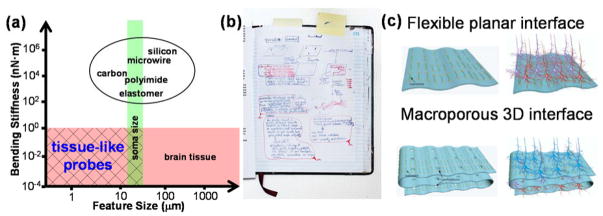Figure 1.
Challenges of state-of-the-art neural probes and original conception of mesh electronics. (a) Comparison of feature size and bending stiffness between existing neural probes [7–9,12,15–17] and a 20~100 μm thick slice of brain tissue. Ideal brain probes should have critical feature sizes and bending stiffness values similar to or smaller than those of the brain tissue to afford ‘tissue-like probes’. (b) Original page from Lieber’s notebook in 2008 showing key idea leading to free-standing 3D neuron-like nanoelectronic devices to interface with neurons in a biological manner. (c) Schematic drawings presented in 2007/2008 talks and NIH proposal illustrating the key concept leading to mesh electronics with porosity that enables interpenetration and integration of neural networks with electronics structure [24].

